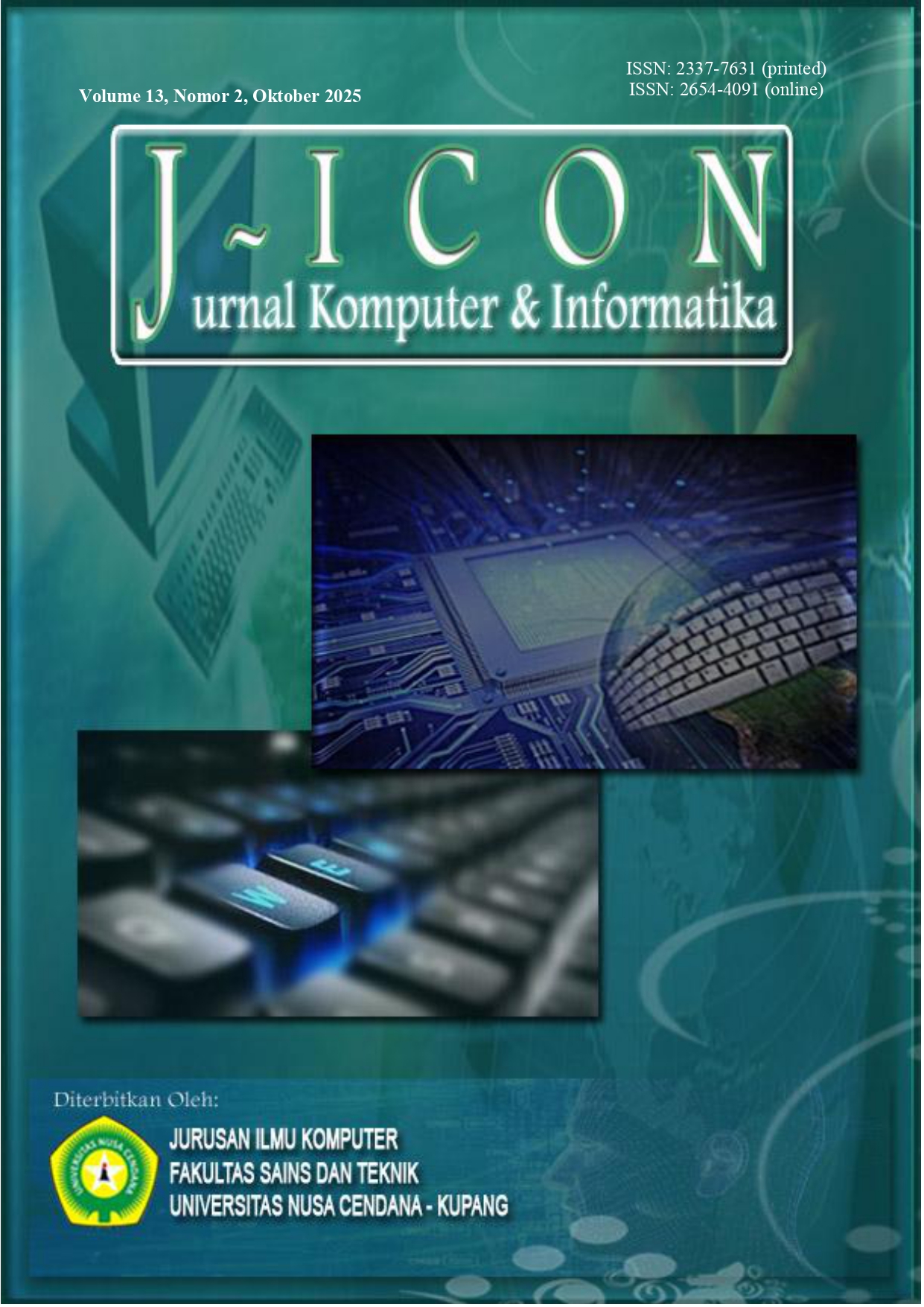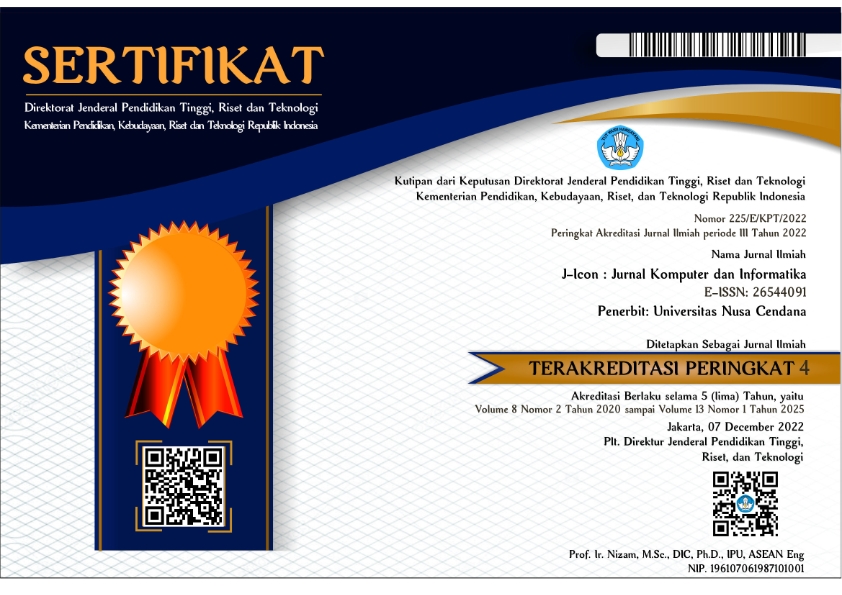DEVELOPMENT OF A 360° VIRTUAL REALITY-BASED ANDROID APPLICATION FOR CAMPUS INTRODUCTION AT WASTUKANCANA COLLEGE OF TECHNOLOGY USING MDLC METHOD
Abstract
This study aims to develop a 360 Virtual Tour application based on Android as an interactive medium to introduce the campus environment of Sekolah Tinggi Teknologi Wastukancana to new students. The application integrates Virtual Reality (VR) technology to provide an immersive exploration experience through 360 panoramic views. Key features include hotspot-based navigation between scenes, automatic audio narration using text-to-speech, and a stereoscopic display mode compatible with Google Cardboard. The development follows the Multimedia Development Life Cycle (MDLC) method, consisting of six stages: concept, design, material collecting, assembly, testing, and distribution. The application was implemented using Unity 2021.3.45 LTS and C# programming language, along with gyroscope sensor support to align the panorama with the user's viewing direction. Functional testing using the blackbox method was conducted with 177 test cases, all of which passed successfully with a 100% success rate. The APK file was distributed through GitHub and Google Sites for direct access by new students. Initial feedback indicated that the application is visually appealing, user-friendly, and capable of delivering a virtual tour experience that closely resembles the real campus environment. These results suggest that the application is effective as a digital campus introduction tool that is informative, practical, and innovative.
Downloads
References
[2] K. Khairunnisa, M. S. Erwin, and W. Victory, “Aplikasi Virtual Tour Reality 360° Pengenalan Lingkungan Kampus Institut Seni Indonesia Padang Panjang Berbasis Website,” Jurnal escience humanity, vol. 5, no. 2, 2024, doi: 10.37296/esci.v5i1.184.
[3] E. Rahmawati, N. Prasastono, A. Susanto, and M. D. Sudiro, “Virtual Tour Sebagai Alternatif Berwisata Di Masa Pandemi Covid-19 (Studi Pada Pelaku Wisata di Yogyakarta),” Pringgitan, vol. 3, no. 1, 2022, [Online]. Available: https://www.ejournal.stipram.ac.id/index.php/pringgitan/article/ view/146/143.
[4] K. R. Subekti, S. Andryana, and R. T. Komalasari, “Virtual Tour Lingkungan Universitas Nasional Berbasis Android dengan Virtual Reality,” JIPI (Jurnal Ilmiah Penelitian dan Pembelajaran Informatika), vol. 6, no. 1, 2021.
[5] J. Bata, “Perancangan Lingkungan Virtual untuk Media Tur Kampus Berbasis Virtual reality,” JIIP (Jurnal Ilmiah Ilmu Pendidikan), vol. 7, no.12, p. 14134-14138, 2024, doi: 10.54371/jiip.v7i12.6446.
[6] Y. Artahsasta, M. Sanglise, and J. P. P. Naibaho, “Pembuatan Aplikasi Virtual tour 360 Sebagai Media Dalam Pengenalan Lingkungan Kampus di Universitas Papua Menggunakan Unity 3D Engine,” Journal of Information Science and Technology, vol. 13, no. 1, 2024.
[7] R. Aryani, U. Khaira, M. A. Razi, D. Arsa, and E. Saputra, “Pedampingan Pemanfaatan Virtual Tour Museum Siginjei Dalam Mendukung Pembelajaran Sejarah Dan Budaya Jambi di SMA IT Ash Shiddiiqi,” Jurnal Pengabdian Kolaborasi dan Inovasi IPTEKS, vol. 2, no. 1, 2024, doi: 10.59407/jpki2.v2i1.430.
[8] A. Rahmatika, A. A. Manurung, and F. Ramadhani, “Pengembangan Media Pembelajaran Berbasis Augmented Reality untuk Meningkatkan Empati Anak Usia Dini dengan Metode MDLC (Multimedia Development Life Cycle),” sudo Jurnal Teknik Informatika, vol. 2, no. 3, pp. 122–130, Sep. 2023, doi: 10.56211/sudo.v2i3.330.
[9] D. Y. Pramesti and R. W. Arifin, “Metode Multimedia Development Life Cycle Pada Media Pembelajaran Pengenalan Perangkat Komputer Bagi Siswa Sekolah Dasar,” Journal of Students Research, vol. 1, no. 2, pp. 109–122, 2020, doi: 10.31599/jsrcs.v1i2.400.
[10] H. A. Musril, J. Jasmienti, and M. Hurrahman, “Implementasi Teknologi Virtual Reality Pada Media Pembelajaran Perakitan Komputer,” JANAPATI, vol. 9, no. 1, 2020, doi: 10.23887/janapati.v9i1. 23215.
[11] W. A. Rahma and S. Riyadi, “Perancangan Virtual tour 360 sebagai Media Pengenalan Wilayah Sekitar Ibu Kota Negara Baru Indonesia,” JURNAL SAINS DAN SENI ITS, vol. 12, no. 1, 2023.
[12] A. B. Semma, “Pemanfaatan 3D Virtual Reality Panoramic Image Dengan Smartphone Menggunakan Metode 3d Side-By-Side dan Continuous Panning,” Multitek Indonesia, vol. 15, no. 2, 2022.
[13] M. Alfian, A. Dwi Putra, and A. Surahman, “Penerapan Augmented Reality (Tanaman Obat Keluarga) Toga Sebagai Media Pembelajaran Berbasis Android Dengan Metode Marker,” Jurnal Informatika dan Rekayasa Perangkat Lunak (JATIKA), vol. 3, no. 1, pp. 77–85, 2022.
[14] R. Y. Ariyana, E. Susanti, and P. Haryani, “Rancangan Storyboard Aplikasi Pengenalan Isen-Isen Batik Berbasis Multimedia Interaktif,” INSOLOGI: Jurnal Sains dan Teknologi, vol. 1, no. 3, pp. 321–331, Jun. 2022, doi: 10.55123/insologi.v1i3.375.
[15] R. Rahmat and N. Noviyanti, “Augmented Reality untuk Materi Bangun Ruang Menggunakan Unity 3D, Vuforia SDK dan Aplikasi Blender,” JURNAL TIKA, vol. 5, no. 3, pp. 86–92, 2020, doi: 10.51179/tika.v5i3.59.
[16] M. Zidan, S. Nur’aini, N. C. H. Wibowo, and M. A. Ulinuha, “Black Box Testing pada Aplikasi Single Sign On (SSO) di Diskominfostandi Menggunakan Teknik Equivalence Partitions,” Walisongo Journal of Information Technology, vol. 4, no. 2, pp. 127–137, 2022, doi: 10.21580/wjit.2022.4.2.12135.
Copyright (c) 2025 Rohmat Rohmat, Muhammad Rafi Muttaqin, Yusuf Muhyidin

This work is licensed under a Creative Commons Attribution 4.0 International License.
The author submitting the manuscript must understand and agree that if accepted for publication, authors retain copyright and grant the journal right of first publication with the work simultaneously licensed under a Creative Commons Attribution (CC-BY) 4.0 License that allows others to share the work with an acknowledgment of the work’s authorship and initial publication in this journal.
 Rohmat Rohmat(1*)
Rohmat Rohmat(1*)




